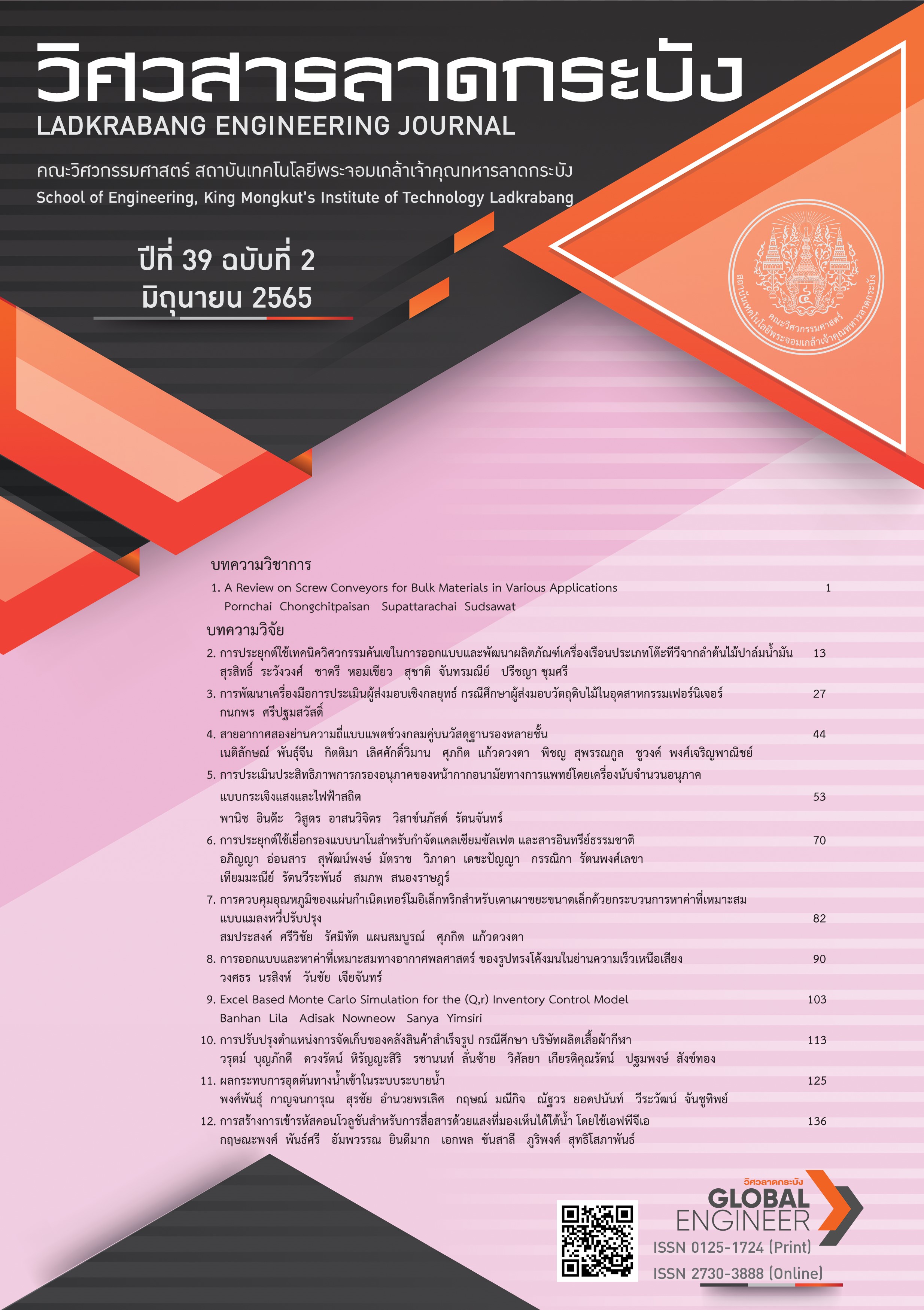ผลกระทบการอุดตันทางน้ำเข้าในระบบระบายน้ำ
คำสำคัญ:
ปัจจัยการอุดตัน, ทางน้ำเข้า, ระบบระบายน้ำ, การไหลในท่อบทคัดย่อ
บทความวิจัยนี้มีวัตถุประสงค์เพื่อศึกษาผลกระทบที่เกิดขึ้นเมื่อทางน้ำเข้าระบบระบายน้ำมีการอุดตันและนำเสนอรูปแบบทางน้ำเข้าที่เหมาะสมต่อการใช้งาน โปรแกรม Storm and Sanitary Analysis 2018 ถูกนำมาใช้ในการวิเคราะห์ระบบระบายน้ำและระดับการท่วมขังที่เกิดขึ้นกับระบบระบายน้ำโครงการบ้านจัดสรรแก่งเสือเต้นวิลเลจ 3 กำหนดให้ทางน้ำเข้าเกิดการอุดตัน 0–90% ภายใต้การเปลี่ยนแปลงรูปแบบทางน้ำเข้า 4 ชนิด ผลการศึกษาแสดงให้เห็นว่าเมื่อเกิดการอุดตัน 50% ทางน้ำเข้าชนิดพื้นถนนตะแกรงสี่เหลี่ยมผสมกับขอบทางเท้าและทางน้ำเข้าชนิดขอบทางเท้ามีระดับการท่วมขังต่ำสุดและสูงสุดโดยไม่เกิน 2 และ 6 เซนติเมตร ตามลำดับ ทางน้ำเข้าชนิดพื้นถนนแบบตะแกรงสี่เหลี่ยมมีความเหมาะสมเมื่อพิจารณาในด้านงบประมาณติดตั้ง ทางน้ำเข้าชนิดพื้นถนนแบบตะแกรงกลมมีความเหมาะสมเมื่อพิจารณาความปลอดภัยในการขับขี่ ทางน้ำเข้าชนิดขอบทางเท้าเป็นตัวเลือกที่ดีเมื่อใช้งานในพื้นที่เสี่ยงต่อการอุดตันต่ำและมีปริมาณน้ำเข้าน้อยเนื่องจากมีราคาถูกที่สุด
References
Post Today, “Rain landslides in Pathum, Sathaphon village for the last 9 years, the cause of garbage clogged pipes,” posttoday.com. https://www.posttoday.com/
social/local/628618. (accessed: Sep. 15, 2021)
Thai Rath Online, “The rain does not drain quickly flooded the houses the reason is because the debris clogs the sewers” thairath.co.th. https://www.thairath.co.th/
news/local/central/122-4942. (accessed: Sept. 22, 2021)
Handbook of Drainage system design and prevent erosion in highway work, Dept. of Highways, Bangkok, Thailand, 2011, pp.25–142.
Drainage system design according to Bangkok standards for small project areas at the housing estate, Dept. of Drainage and Sewerage, Bangkok, Thailand, 1992, pp. 1–15.
Standard of Wastewater and Storm Drainage System, Dept. of Local Administration, Bangkok, Thailand, 2012, pp. 17–26.
J. C. Y. Guo, “Design of grate inlets with a clogging factor,” Advances in Environmental Research, vol. 4, no. 3, pp. 181–186, 2000, doi: 10.1016/S1093-0191(00)00013-7
J. C. Y. Guo, “Design of Street Curb Opening Inlets Using a Decay-Based Clogging Factor,” Journal of Hydraulic Engineering, vol. 132, no. 11, pp. 1240–1241, 2006, doi: 10.1061/(ASCE)0733-9429(2006)132:11(1237).
M. Gómez, G. H. Rabasseda and B. Russo, “Experimental campaign to determine grated inlet clogging factors in an urban catchment of Barcelona,” Urban Water Journal, vol. 10, no. 1, pp. 50–60, 2012, doi: 10.1080/1573062X.2012.690435.
Autodesk Storm and Sanitary Analysis 2018 User’s Guide, ADSK., San Rafael, CA, USA, 2017, pp. 244.
N. Inwong, “Discharge Forecasting in Yom and Nan Rivers by KUnet Artificial Neural Networks Program,” M.S. Thesis, Dept. WRE., Kasetsart Univ., Bangkok, Thailand, 2006.
Urban Drainage and Flood Control District Urban Storm Drainage Criteria Manual, 1st ed., UDFCD., Denver, CO, USA, 2017, pp. 7–28.
A. Rittima, K. Piemfa, N. Uthai and A. Jantaramana, “An Improvement of Design Rainfall Analysis of the Central Basin of Thailand,” Research and development journal, vol. 24, no.4, pp. 28–38, 2013.
J. E. Nash and J. V. Sutcliffe, “River flow forecasting through conceptual models; Part I-a discussion of principles,” Journal of Hydrology, vol. 10, pp. 282–290, 1970, doi: 10.1016/0022-1694(70)90255-6.
D. N. Moriasi, J. G. Arnold, M. W. Van Liew, R. L. Bingner, R. D. Harmel and T. L. Veith, “Model evaluation guidelines for systematic quantification of accuracy in watershed simulations,” Transactions of the ASABE, vol. 50, no. 3, pp. 885–900, 2007, doi: 10.13031/2013.23153.
T. S. Hogue, S. Sorooshian, H. Gupta, A. Holz and D. Braatz, “A multistep automatic calibration scheme for river forecasting models,” Journal of Hydrometeorology, vol. 1, no. 6, pp. 524–542, 2000.
B. M. Fiseha, S. G. Setegn, A. M. Melesse, E. Volpi and A. Fiori, “Hydrological analysis of the Upper Tiber River Basin, Central Italy: a watershed modelling approach,” Hydrological Processes, vol. 27, no. 16, pp. 2339–2351, 2012, doi: 10.1002/hyp.9234.
S. A. Lottes, M. A. Sitek and N. Sinha, “Computational analysis of water film thickness during rain events for assessing hydroplaning risk Part 1: Nearly smooth road surfaces,” NSED U.S. Dept. of Energy Labs., Argonne, IL, USA, Rep. ANL-20/36; 162558, 2020.
R. Veerappan and J. Le, “Hydraulic efficiency of road drainage inlets for storm drainage system under clogging effect.” presented at the 5th Int. Conf. Flood Risk Management and Response, San Servolo, Italy, 2016, pp. 271–281, doi: :10.2495/UW160241.
Downloads
เผยแพร่แล้ว
How to Cite
ฉบับ
บท
License
Copyright (c) 2022 คณะวิศวกรรมศาสตร์ สถาบันเทคโนโลยีพระจอมเกล้าเจ้าคุณทหาร

This work is licensed under a Creative Commons Attribution-NonCommercial-NoDerivatives 4.0 International License.
บทความที่ได้รับการตีพิมพ์เป็นลิขสิทธิ์ของคณะวิศวกรรมศาสตร์ สถาบันเทคโนโลยีพระจอมเกล้าเจ้าคุณทหารลาดกระบัง
ข้อความที่ปรากฏในบทความแต่ละเรื่องในวารสารวิชาการเล่มนี้เป็นความคิดเห็นส่วนตัวของผู้เขียนแต่ละท่านไม่เกี่ยวข้องกับสถาบันเทคโนโลยีพระจอมเกล้าเจ้าคุณทหารลาดกระบัง และคณาจารย์ท่านอื่นๆในสถาบันฯ แต่อย่างใด ความรับผิดชอบองค์ประกอบทั้งหมดของบทความแต่ละเรื่องเป็นของผู้เขียนแต่ละท่าน หากมีความผิดพลาดใดๆ ผู้เขียนแต่ละท่านจะรับผิดชอบบทความของตนเองแต่ผู้เดียว






